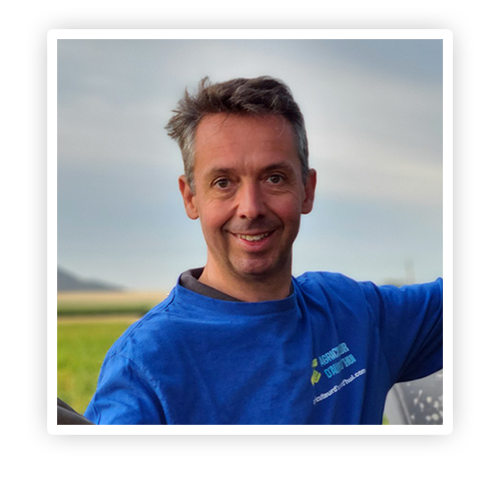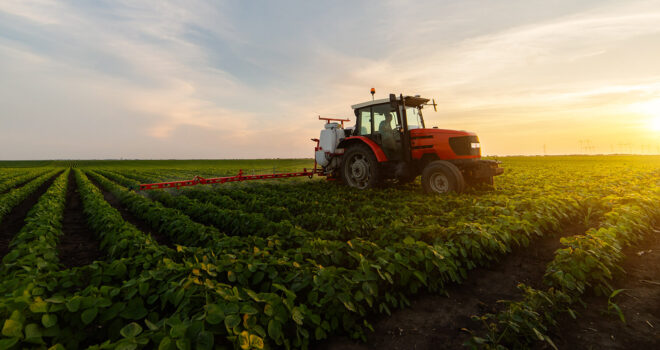How is agriculture evolving to become more sustainable? How can we make vegetables more accessible to consumers? Meet Thierry Baillet, a farmer and YouTuber, who shares his passion for his work.

Who is Thierry Baillet?
- Age 49
- Farmer in the Nord-Pas-de-Calais region (Loos-en-Gohelle)
- Multiple crop farming (peas, beetroot, potatoes, rapeseed, wheat, onions, pumpkins, carrots)
- YouTuber and active on social media
- Author of the book ‘Dans les bottes de ceux qui nous nourrissent’ (In the boots of those who feed us)
Born into a farming family, Thierry Baillet has been running his farm since the age of 23. Interested in science, he has gradually developed his estate. From traditional mixed farming, he has moved on to more sustainable agriculture, with part of his farm converted to organic culture. He likes to share his passion for agriculture, his thoughts, his joys and his outbursts on social media. In seven years, he has developed a community of 84,000 followers on YouTube, 35,000 on Facebook, 10,000 on Instagram and 8,000 on Twitter.
Why is sustainable food a priority for you?
It just became self-evident, even more so since I have been active on social media. This encourages me to think about what I am putting in place, both for the quality of the food itself, but also for the environment. I get direct feedback from farmers and consumers, who have a positive mindset about sustainability. I like to think things through and get to the bottom of things. I am not for a single model, but for the plurality of agriculture. For example, ‘all organic’ is not an absolute solution, and technology is useful for moving towards more sustainable models.
Read also: Europeans: prepared to adopt a more sustainable diet
How can we make vegetables more accessible to consumers?
I think a lot needs to be done in terms of consumer education. In many countries, there are plenty of vegetables in supermarkets. The supply is there, but we need greater consumer demand. We also need to overcome some financial obstacles: it is not more expensive to prepare your own vegetables than to buy a ready meal!
Another factor in people eating fewer vegetables is the fact that our society increasingly “doesn’t have time”. Or rather that we don’t take the time to prepare our food. The result is that some generations are incapable of cooking vegetables or even preparing the simplest meals.
Finally, there is the role of the retailer in adding value: too often, they promote discounts over quality. The percentage of household expenditure spent on food has been in steady decline for the past 50 years. Yet quality has a cost, and quality food should be a priority.
Find out more about the Foundation’s field initiatives aimed at improving eating habits.
How can sustainable food improve accessibility?
If we make consumers think about their food, they can become more aware and understand the importance of sustainability, of a more environmentally friendly agriculture. One way to do this is to favour short supply circuits, such as buying directly from the farm. It’s also important to work together: farmers, processors, traders and consumers can make a difference. It’s not a good thing if the consumer wants to buy at the cheapest price, nor if the distributor’s margin is too high, or if farmers can’t live from their work. We need to reassess the value of agricultural products.
What techniques do you use in your approach to sustainability?
Technology is very useful in limiting inputs, namely fertilisers and plant protection products. For fertilisers, I analyse the soil and only apply what is necessary. A soil map allows me to apply just the right amount of fertiliser, at the right time and in the right place. It’s ‘precision agriculture’. We also have tools that help us to limit the use of plant protection products thanks to predictive risk modelling on crop diseases.
What are your hopes for the food of tomorrow?
We need to re-establish the connection between producers and consumers by working with intermediaries. A product like a vegetable comes from a region, it has been grown by a farmer in order to be eaten. It’s really important to put the human element back into this process. I encourage you to go out and meet the farmers in your region!



 Artichoke
Artichoke  Chard
Chard  Vegetable garden: growing melon
Vegetable garden: growing melon 









